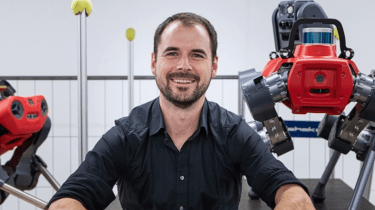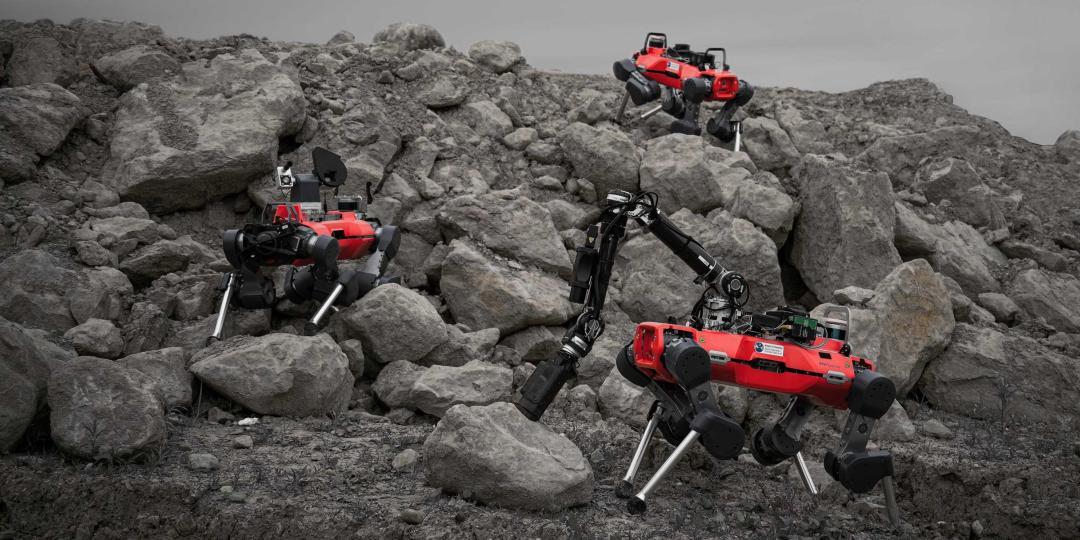
🔷 Marco Hutter, you’ve reduced your workload as a professor to 50% and are now working 50% as head of the Robotics and AI Institute in Zurich. How did that come about?
I was contacted by Marc Raibert, the founder of Boston Dynamics and father of modern legged locomotion. He was leaving the company and was planning a new research centre for robotics and AI in Boston (the RAI Institute), funded by Hyundai. He wanted me to be involved. I agreed – on the condition that we set something up in Zurich.
🔷 Weren’t you tempted to move to Boston?
No, Switzerland is where my heart is. And I think developing something major here in the field of robotics and AI is a huge opportunity for Zurich and for Switzerland. So during my sabbatical two years ago I went to the US and planned the development of the Swiss RAI office.
Silicon Valley of Robotics
Silicon Valley of Robotics
Switzerland is known as the Silicon Valley of Robotics and the Greater Zurich Area contributes considerably to this peak position: Its universities and technology companies belong among the world’s leaders in autonomous & intelligent systems, computer vision, sensor technology, and artificial intelligence.
🔷 Why did Marc Raibert accept the proposal?
At the RAI Institute we want to bring together the best talent from research at the interface between robotics and artificial intelligence, and that is where ETH plays a leading role. Our research group has also made a mark specifically in the field of legged robotics and the application of reinforcement learning for locomotion. Boston has MIT and Zurich has ETH – so it’s ideal for a research institute in robotics to be based at these two top locations.
🔷 And what appealed to you about this new job?
The institute opens up new possibilities for our research, but also career opportunities for young researchers at ETH and from all over the world. It combines the advantages of research at a university with those at an industrial company. We can hire experienced researchers on permanent contracts with competitive salaries and therefore carry out complex and long-term research projects. Robotics is famously very hardware-intensive and requires a great deal of engineering. At the RAI Institute we have a large team and the necessary infrastructure.
🔷 How big is the team?
The institute as a whole has over 250 employees globally, in Zurich there’s around 30 of us, and that number will soon rise to 50. The two locations work together closely, particularly in infrastructure. So we have a software group that takes care of the infrastructure for machine learning-based approaches, and a hardware group that builds and maintains the robots. (...) The RAI Institute allows us to pool everything on one site, from the idea stage to implementation. Thanks to a framework agreement that we’ve signed with ETH, there will be unique opportunities for both researchers and for students.

🔷 In what form will collaboration take place? (This is a shortened and adapted summary of the original content.)
We’ve signed a framework agreement with the RAI Institute that allows us to launch specific projects between ETH and the RAI. In addition to the framework agreement with ETH, the RAI Institute has also signed a donation agreement with the ETH Foundation USA. A research framework agreement allows direct collaboration between ETH and the RAI on selected topics, while the donation will also fund new research projects at ETH in the field of robotics. This creates a network that promotes innovation and further bolsters ETH as a leading institution in Europe.
🔷 You’ve been working at RAI Zurich for a year now and the offices were inaugurated yesterday. What reactions have you received so far?
The space is great and the researchers seem really happy. There has been a lot of very positive feedback from both ETH and the department on the RAI set-up in general. We have to explore new paths in robotics and AI to satisfy the high level of student interest in this area while maintaining educational excellence. Currently, a small proportion of robotics professors are shouldering a disproportionately high number of Bachelor’s and Master’s theses and semester projects. So if the experienced researchers at RAI are able to provide additional support, that will help.
🔷 Has there been a response from outside ETH?
I’m noticing that Zurich as a location is becoming more attractive. All the companies that are locating to the city are creating a positive spiral – and RAI is definitely part of that. This also improves the situation for our start-ups, which have been able to raise venture capital more easily in recent years.

This article was originally published by ETH Zurich News in September 2025 and authored by Roland Baumann.
Related news
Meet with an expansion expert
Our services are free of charge and include:
- Introduction to key contacts in industry, academia, and government
- Advice on regulatory framework, taxes, labor, market, and setting up a company
- Custom-made fact-finding visits, including office and co-working space
